ENFANTS TERRIBLES
enfants-terribles
enfants-terribles
You also want an ePaper? Increase the reach of your titles
YUMPU automatically turns print PDFs into web optimized ePapers that Google loves.
GRAPH 55: The different types of energy infrastructure<br />
investments. Source: our own calculations based<br />
on approved Operational Programmes according to<br />
categories of intervention<br />
do not represent significant innovation. While new boilers<br />
do bring energy savings, more attention should be given to<br />
the assessment of how much a subsidy is necessary for gas<br />
heating and how much should be left to financial instruments<br />
or Energy Performance Contracting.<br />
NOT SO SMART GRIDS<br />
Both investment into renewables as well as the allocation for<br />
smart grids and transmission are rather low: investments<br />
into intelligent energy distribution systems at medium and<br />
low voltage levels will total over EUR 37 million, with the<br />
total amount of renewable sources up to EUR 53 million<br />
(See graph 55). Counter-intuitively, and contradicting the<br />
Partnership Agreement, these investments are not aimed<br />
at decarbonisation and the integration of renewables. The<br />
result indicators chosen for this part of the Enterprise and<br />
Innovation for Competitiveness Operational Programme are<br />
the SAIDI and SAIFI – the annual average number and time of<br />
interruptions in power supply per consumer. Reaching these<br />
targets, the grid will definitely be of a better quality and the<br />
monopolistic operators able to finance maintenance and<br />
innovation that they would need to do anyway. In terms of<br />
renewables, connectivity may or may not be a side-effect of<br />
the measures.<br />
euro<br />
84% Enegry Efficiency 1.946.794.584<br />
9% Electricity transmission, storage 199.833.699<br />
4% Co-generation, district heating 92.942.859<br />
2% Renewable Energy Sources 53.439.383<br />
2% Smart Grid 37.118.139<br />
0% Gas 0<br />
An allocation of almost EUR 200 million for electricity<br />
transmission grid modernisation that should increase<br />
energy security, stability of supply and contribute to<br />
the completion of the EU single power market is also<br />
questionable. This allocation was originally reported under<br />
Thematic Objective 4, but as its contribution to the shift<br />
to a low-carbon economy could not be proved, it had to be<br />
moved to Objective 7. The state-owned ČEPS plans to limit<br />
cross-border spillovers from wind power in Germany and to<br />
provide new connections for coal power plants in the north<br />
and for the non-existent new reactors at the Temelin plant.<br />
This finance would just serve as a financial injection for the<br />
grid operator and would bring no added value nor improve<br />
Czech competitiveness.<br />
For a successful transition to a low-carbon economy,<br />
it is necessary to implement climate protection across<br />
‘Climate’s enfants terribles: how new Member States’ misguided use of EU funds is holding back Europe’s clean energy transition’ 91


